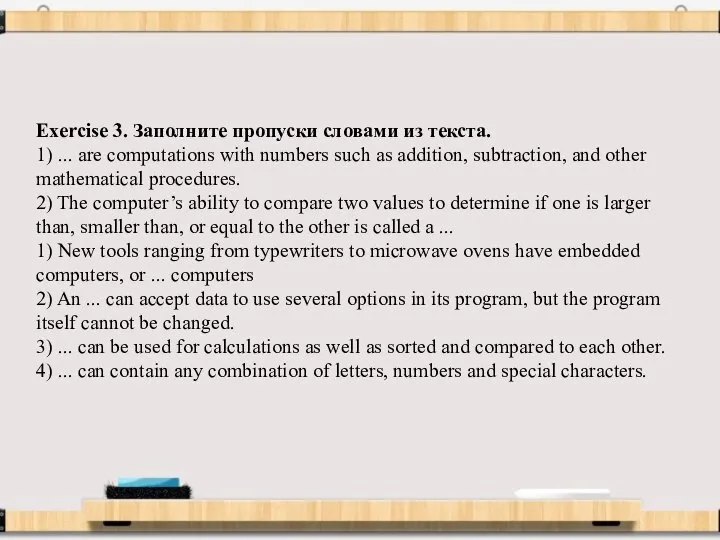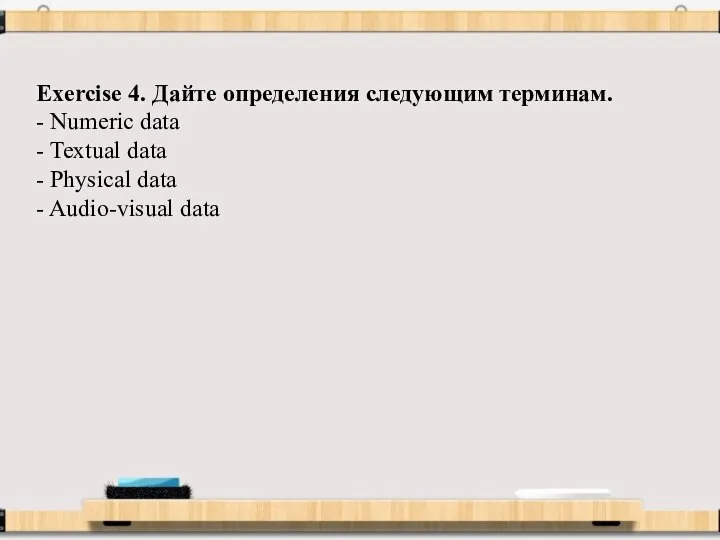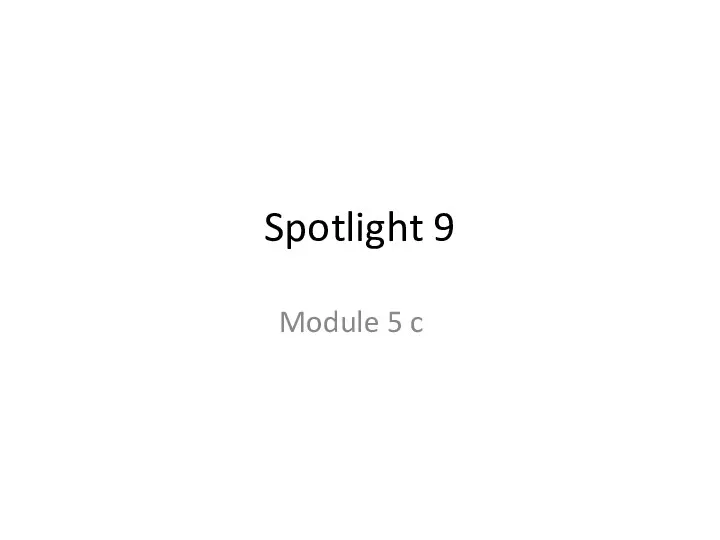- Главная
- Английский язык
- Types of data

Содержание
- 2. computation – вычисления arithmetic operations – арифметическая операция logical operation – логическая операция subtraction – вычитание
- 3. Read and translate the text. Types of data With the advent of new computer applications and
- 4. Exercise 2. Ответьте на вопросы к тексту. 1) In what two major parts could be computer
- 5. Exercise 3. Заполните пропуски словами из текста. 1) ... are computations with numbers such as addition,
- 6. Exercise 4. Дайте определения следующим терминам. - Numeric data - Textual data - Physical data -
- 8. Скачать презентацию
Слайд 2computation – вычисления
arithmetic operations – арифметическая операция
logical operation – логическая операция
subtraction –
computation – вычисления
arithmetic operations – арифметическая операция
logical operation – логическая операция
subtraction –

вычитание
to benefit – получать пользу to compute - вычислять
equal – равный to divide – делить
to determine – определять data – данные
to compare – сравнивать save – спасать (здесь экономить)
comparison – сравнение decimal point – десятичная точка
value – величина increase – увеличивать
tool – инструмент addition – сложение
to expand – расширять false – ложный
microwave oven – микроволновая печь sequence – последовательность
embedded – встроенный advent – приход
accept – принимать flexible – гибкий, изменчивый
to benefit – получать пользу to compute - вычислять
equal – равный to divide – делить
to determine – определять data – данные
to compare – сравнивать save – спасать (здесь экономить)
comparison – сравнение decimal point – десятичная точка
value – величина increase – увеличивать
tool – инструмент addition – сложение
to expand – расширять false – ложный
microwave oven – микроволновая печь sequence – последовательность
embedded – встроенный advent – приход
accept – принимать flexible – гибкий, изменчивый
Working vocabulary
Слайд 3
Read and translate the text.
Types of data
With the advent of new
Read and translate the text.
Types of data
With the advent of new

computer applications and hardware, the definition of data has expanded to include many types.
Numeric data consists of numbers and decimal points, as well as the plus (+) and minus (-) signs. Both arithmetic operations and logical operations are performed on numeric data. This means that numbers can be used for calculations as well as sorted and compared to each other.
Text, or textual data, can contain any combination of letters, numbers and special characters. Sometimes textual data is known as alphanumeric data.
Various forms of data that we can hear and see makes up audio-visual data. The computer can produce sounds, music and even human voice. It can also accept audio information as an input. Data can also take form of drawings and video sequences.
Physical data is captured from the environment. For example, light, temperature and pressure are all types of physical data.
In many large buildings, computer systems process several kinds of physical data to regulate operations. Computers can set off security alarms, control temperature and humidity, or turn lights on and off, all in response to physical data. These applications increase people's safety and save the time and money.
Numeric data consists of numbers and decimal points, as well as the plus (+) and minus (-) signs. Both arithmetic operations and logical operations are performed on numeric data. This means that numbers can be used for calculations as well as sorted and compared to each other.
Text, or textual data, can contain any combination of letters, numbers and special characters. Sometimes textual data is known as alphanumeric data.
Various forms of data that we can hear and see makes up audio-visual data. The computer can produce sounds, music and even human voice. It can also accept audio information as an input. Data can also take form of drawings and video sequences.
Physical data is captured from the environment. For example, light, temperature and pressure are all types of physical data.
In many large buildings, computer systems process several kinds of physical data to regulate operations. Computers can set off security alarms, control temperature and humidity, or turn lights on and off, all in response to physical data. These applications increase people's safety and save the time and money.
Слайд 4Exercise 2. Ответьте на вопросы к тексту.
1) In what two major parts
Exercise 2. Ответьте на вопросы к тексту.
1) In what two major parts

could be computer operations divided?
2) What are arithmetic operations?
3) What are logical operations?
4) Can computer compare two graphical objects?
5) What makes computer so different from other tools?
6) What is embedded computer? What modern devices have embedded computers?
2) What are arithmetic operations?
3) What are logical operations?
4) Can computer compare two graphical objects?
5) What makes computer so different from other tools?
6) What is embedded computer? What modern devices have embedded computers?
Слайд 5Exercise 3. Заполните пропуски словами из текста.
1) ... are computations with numbers
Exercise 3. Заполните пропуски словами из текста.
1) ... are computations with numbers

such as addition, subtraction, and other mathematical procedures.
2) The computer’s ability to compare two values to determine if one is larger than, smaller than, or equal to the other is called a ...
1) New tools ranging from typewriters to microwave ovens have embedded computers, or ... computers
2) An ... can accept data to use several options in its program, but the program itself cannot be changed.
3) ... can be used for calculations as well as sorted and compared to each other.
4) ... can contain any combination of letters, numbers and special characters.
2) The computer’s ability to compare two values to determine if one is larger than, smaller than, or equal to the other is called a ...
1) New tools ranging from typewriters to microwave ovens have embedded computers, or ... computers
2) An ... can accept data to use several options in its program, but the program itself cannot be changed.
3) ... can be used for calculations as well as sorted and compared to each other.
4) ... can contain any combination of letters, numbers and special characters.
Слайд 6Exercise 4. Дайте определения следующим терминам.
- Numeric data
- Textual data
- Physical data
-
Exercise 4. Дайте определения следующим терминам.
- Numeric data
- Textual data
- Physical data
-

Audio-visual data
- Предыдущая
Художественный труд Домашние животныеСледующая -
Формирование комфортной городской среды Spotlight 9. Module 5c
Spotlight 9. Module 5c Презентация на тему Времена года (3 класс) повторение
Презентация на тему Времена года (3 класс) повторение  Body parts (lesson 4)
Body parts (lesson 4) Reading (а краткий)
Reading (а краткий) UNIT 1A. Starting up
UNIT 1A. Starting up My favourite day
My favourite day Verb To Be
Verb To Be The Past Simple Tense
The Past Simple Tense Read. Читать
Read. Читать Guess the country
Guess the country Cute Description
Cute Description Alphabet clouds
Alphabet clouds Health and body
Health and body Composition. Словосложение
Composition. Словосложение Garden of Eden
Garden of Eden Pete the Cat. I love my white shoes
Pete the Cat. I love my white shoes Презентация на тему Моя семья
Презентация на тему Моя семья  Customer Deliveries
Customer Deliveries Angelina is a talented ballerina! Lesson 6-7
Angelina is a talented ballerina! Lesson 6-7 Rules of good health
Rules of good health Forms of word formation
Forms of word formation ЕГЭ по английскому. Секрет английских времен
ЕГЭ по английскому. Секрет английских времен Write as many new words as you can
Write as many new words as you can Grammar B2. Used to and would
Grammar B2. Used to and would Тренажер по английскому
Тренажер по английскому Wild Animals 3
Wild Animals 3 By HelenLapt
By HelenLapt Conditionals
Conditionals